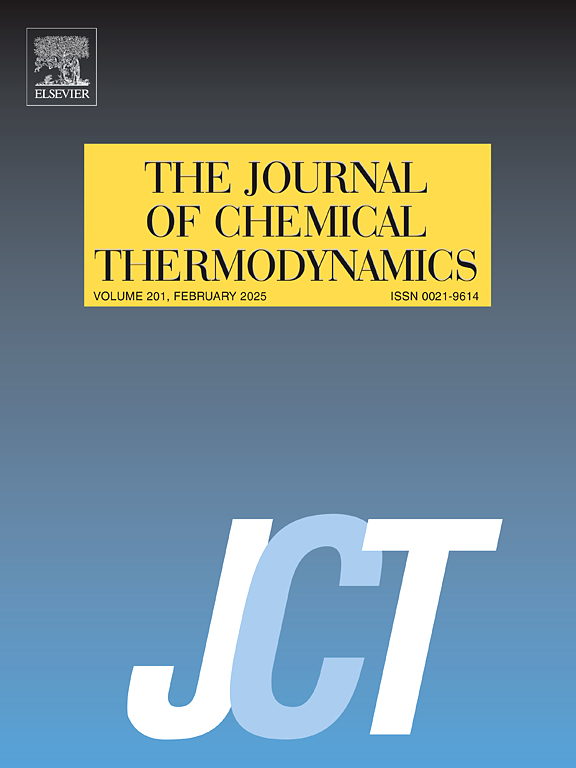对苯二甲酸+4-羧基苯甲醛+对甲苯+ n -甲基吡咯烷酮的季元体系:相互溶解度测定及相关性与量子化学研究
IF 2.2
3区 工程技术
Q3 CHEMISTRY, PHYSICAL
引用次数: 0
摘要
本文采用等温溶解法,在298.15开尔文温度下,在101.0 kPa下获得了季对苯二甲酸(TA)、对甲苯(p-TLA) + 4-羧基苯甲醛(4-CBA) + n -甲基吡咯烷酮(NMP)体系的实验溶解度数据。通过j本文章由计算机程序翻译,如有差异,请以英文原文为准。

Quaternary system of terephthalic acid +4-carboxybenzaldehyde + p-toluic acid + N-methylpyrrolidone: Mutual solubility determination and correlation together with quantum chemistry research
At 298.15 Kelvin, the method of isothermal dissolution was utilized in this current work at 101.0 kPa to obtain the experimental solubility data for the quaternary terephthalic acid (TA), p-toluic acid (p-TLA) + 4-carboxybenzaldehyde (4-CBA) + N-methylpyrrolidone (NMP) system. Generation of the quaternary phase diagram was made through the Jãneck approach, which was based on the mutual solubility that was determined. Three zones of neat solid crystallization, one invariant point, along with three co-saturated curves, were included in the quaternary phase diagram. The three solids that were validated by Schreinemaker approach of wet residue were pure p-TLA, pure 4-CBA, and pure TAˑ2NMP, an adduct of TA with NMP with a mole ratio of 1:2. The area where TAˑ2NMP crystallizes is larger compared to that for p-TLA and 4-CBA. In addition, the model of NRTL was used to mathematically correlate and calculate the quaternary solid-liquid phase diagram. The experimental quaternary phase diagram was found to be in good agreement with the computed one obtained from the NRTL model as evidenced by a root-mean-square deviation of 0.14632 and a relative average deviation of 5.01 %. Separating TA from its mixtures by solvent adduct crystallization might be fundamentally supported by the quaternary phase diagram and thermodynamic models. Considering the investigation on the independent gradient model based on Hirshfeld partitions, as well as the 2D fingerprint plot and difference map of electron density, density difference and difference map of ELF analysis, the van der Waals forces are viewed as favorable weak interactions during the process of forming the adduct of TAˑ2NMP.
求助全文
通过发布文献求助,成功后即可免费获取论文全文。
去求助
来源期刊

Journal of Chemical Thermodynamics
工程技术-热力学
CiteScore
5.60
自引率
15.40%
发文量
199
审稿时长
79 days
期刊介绍:
The Journal of Chemical Thermodynamics exists primarily for dissemination of significant new knowledge in experimental equilibrium thermodynamics and transport properties of chemical systems. The defining attributes of The Journal are the quality and relevance of the papers published.
The Journal publishes work relating to gases, liquids, solids, polymers, mixtures, solutions and interfaces. Studies on systems with variability, such as biological or bio-based materials, gas hydrates, among others, will also be considered provided these are well characterized and reproducible where possible. Experimental methods should be described in sufficient detail to allow critical assessment of the accuracy claimed.
Authors are encouraged to provide physical or chemical interpretations of the results. Articles can contain modelling sections providing representations of data or molecular insights into the properties or transformations studied. Theoretical papers on chemical thermodynamics using molecular theory or modelling are also considered.
The Journal welcomes review articles in the field of chemical thermodynamics but prospective authors should first consult one of the Editors concerning the suitability of the proposed review.
Contributions of a routine nature or reporting on uncharacterised materials are not accepted.
 求助内容:
求助内容: 应助结果提醒方式:
应助结果提醒方式:


